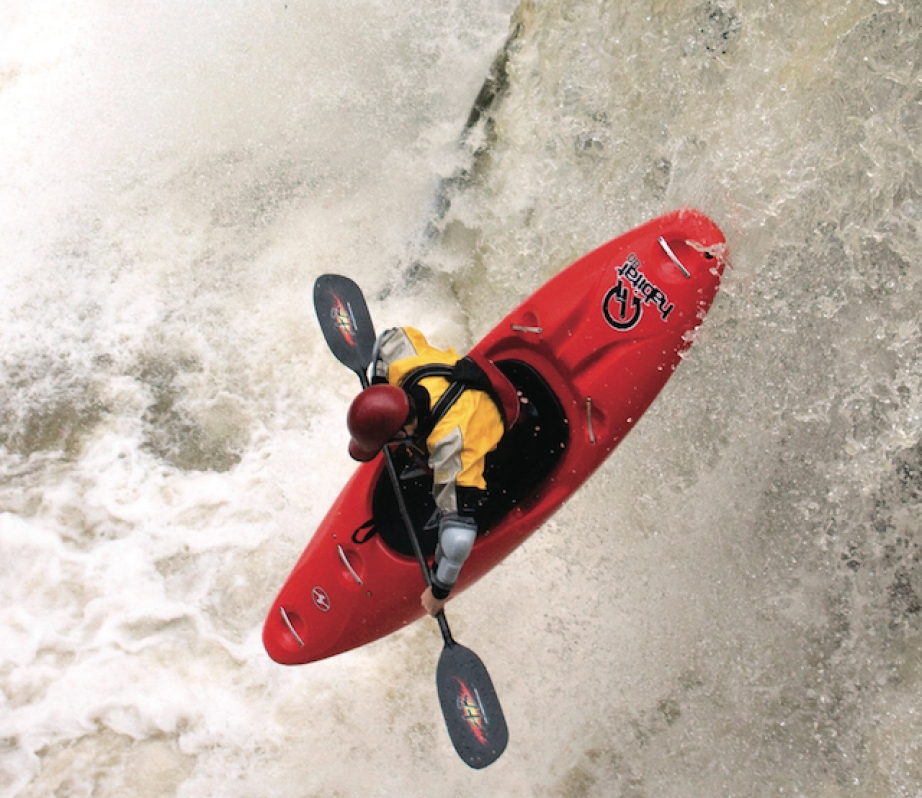Running big waterfalls can be one of the most dangerous aspects of kayaking. Witness professional kayaker Dunbar Hardy, who endured 10 days in traction followed by a year of rigorous physiotherapy after breaking his back on a 50-foot falls in Ecuador. Or Corran Addison, who says he still feels intense pain nearly 20 years after shattering vertebrae on a 70-foot drop. Both injuries occurred landing flat from too great a height. When scouting a significant drop, the foremost decision for any paddler is whether to boof for a dry, flat landing or plug for a wet nosedive into the plunge pool.
To Boof, or not to Boof?
Identifying whether a landing is soft enough to absorb a flat landing takes practice and experience. As a general rule however, the more flow going over a drop, the more aerated the water at the bottom. Frothy, aerated water acts like an airbag in a vehicle and makes for a softer landing. If there is very little flow going over a drop, the green water below provides very little cushioning so landing flat can feel a lot like slamming onto a concrete floor. Nearly all of your boat’s momentum stops upon impact, forcing your body—mostly your spine—to absorb the shock. Therefore, the higher the drop and greener the landing, the more vertically you’ll want your boat to enter.
Tuck it in
Consider this: you have left the lip of a waterfall that you planned to plug but are now falling flat to the pool below. To save your spine, you need to drop your bow for a more vertical entry. The easiest way to do this is to tuck your body hard against your front deck. Shifting your weight forward like this will slowly start to angle your bow downwards. When you’re running a fairly large drop, staying in this position will cause your boat to become more vertical throughout the fall. Tucking forward also curves your spine which helps protect your back. If your bow doesn’t drop enough and you are still headed for a flat landing, prepare to be slammed against your front deck. Turn your head to one side so your helmet takes the impact instead of your nose.
Stomp the drop
A second method to get vertical is to stomp the drop. Stomping involves aggressively changing your angle in mid-air. It is more difficult than simply tucking forward and hoping for the best, but it’s also more effective on medium-sized drops when you don’t have enough time for a slow-motion weight transfer.
Think of your body as a swiss army knife. Start closed in an aggressive forward position on your front deck, pulling your knees to your chest. Move to an open position by sitting up and leaning slightly back while pushing your legs and heels away from your upper body. While the stomp can drop your bow quickly, it also leaves your body in a very vulnerable position. The secret to stomping safely is to tuck forward again just before landing. This motion can pull your bow back up so be careful to shift your weight forward slowly by crunching your abs rather than pulling up with your knees.
The stomp technique works really well for small, quick angle adjustments and is best suited to shorter drops. With such potential for serious injury, it pays to practice both of the recoveries described above. Practice stomping drops that you can boof safely so you don’t risk injury if you land wrong. Although the stomp is very effective in the right situation, tucking onto your front deck goes a long way to protecting your back in all scenarios.
Kelsey Thompson is a professional kayaker and three-time member of the Canadian Freestyle Kayak Team.





